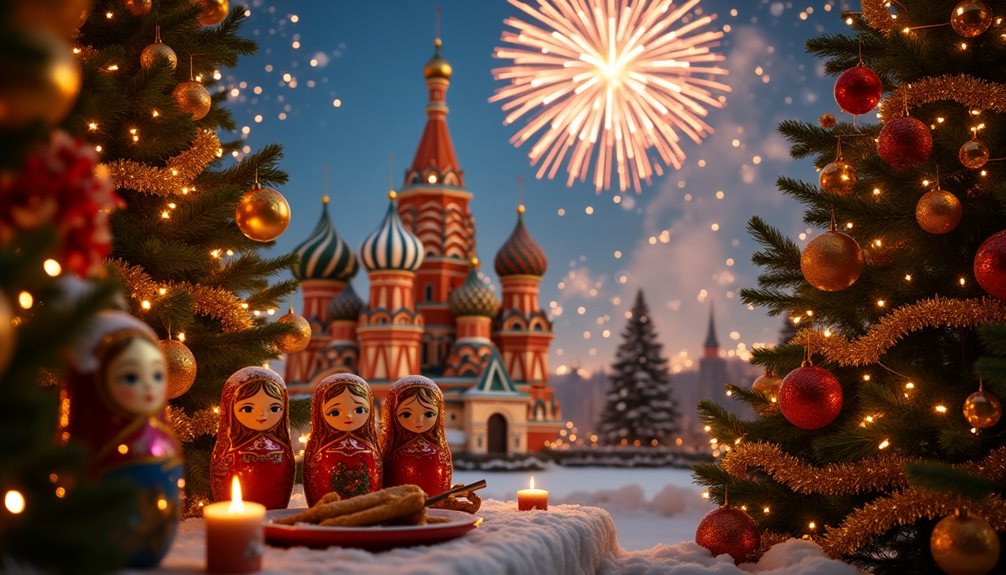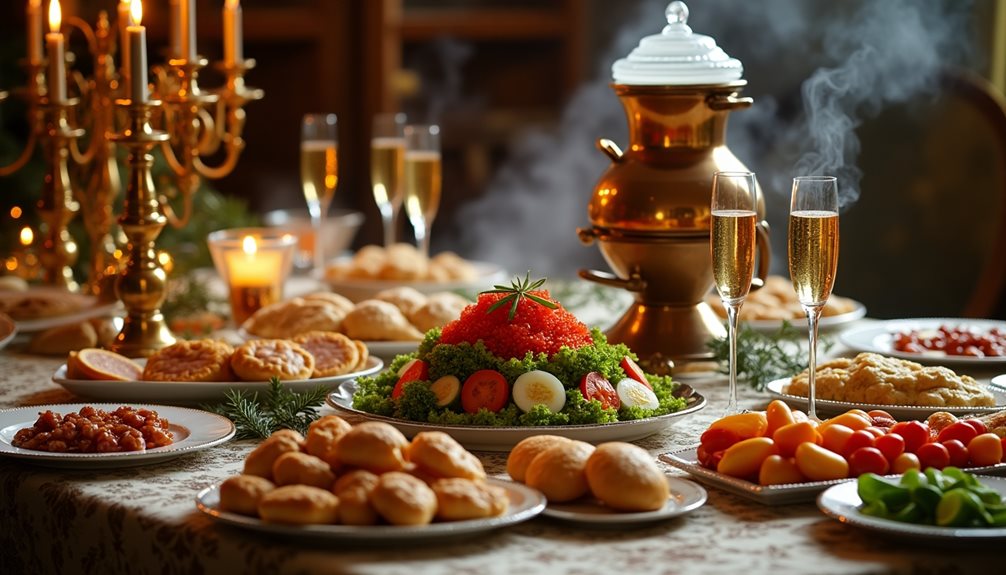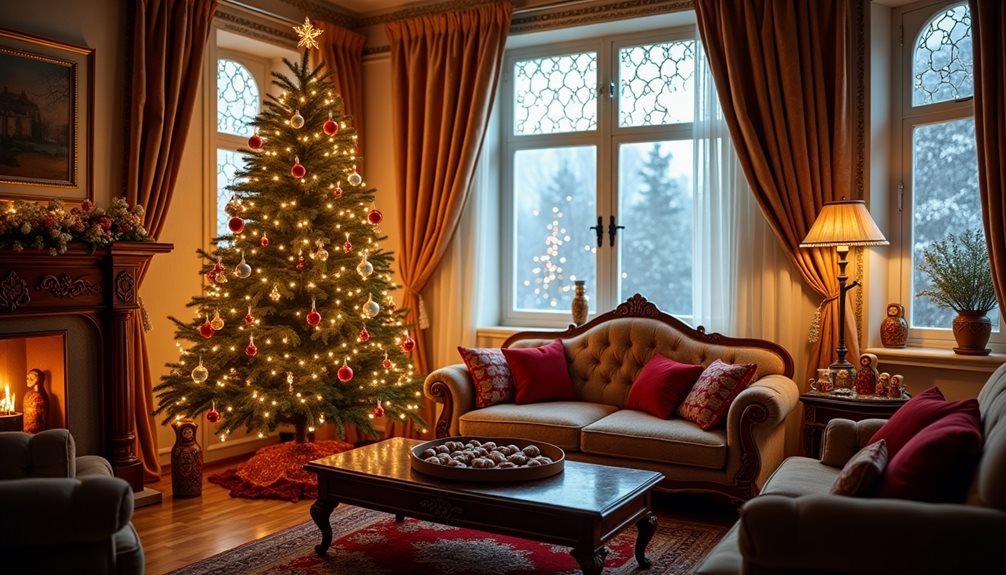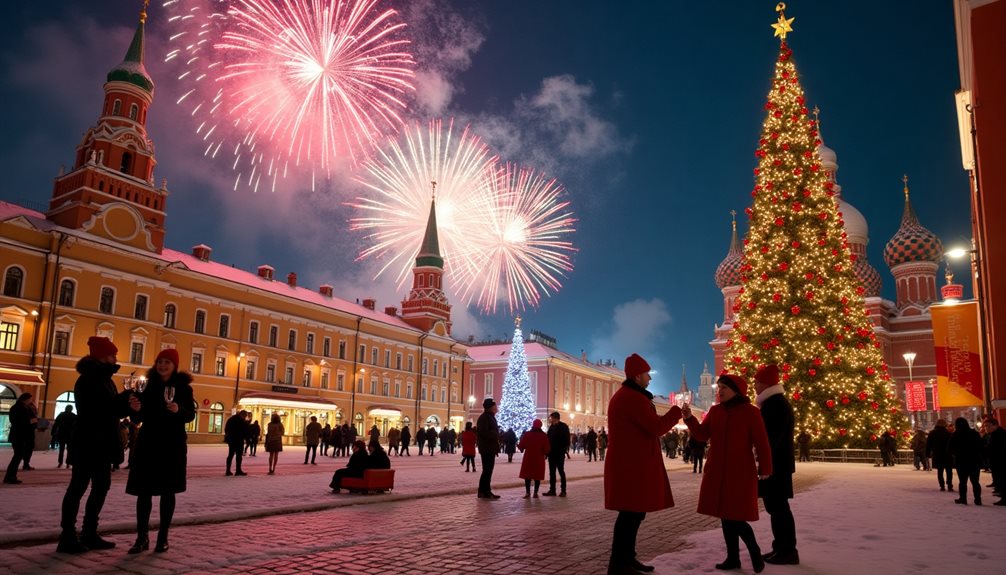Russia’s New Year traditions are a fascinating blend of history, folklore, and modern-day celebrations, offering a unique lens into the cultural heart of the nation. As the country marks this significant holiday, the presence of Ded Moroz and Snegurochka brings a touch of magic, while traditional dishes such as Olivier Salad convey a sense of abundance and prosperity. The celebrations are not merely festive; they are deeply symbolic, encapsulating themes of renewal and community. What deeper meanings and origins lie behind these time-honored customs, and how do they continue to shape Russian identity today?
Historical Roots of New Year

The origins of the New Year celebration in Russia can be traced back to pre-Christian times when Slavic tribes marked the arrival of spring as a period of renewal. This early observance was deeply connected to agrarian cycles, emphasizing the significance of nature in their daily lives. Rituals during this time often included feasting and various customs aimed at ensuring a bountiful harvest.
With the introduction of Christianity in 988 CE, significant transformations occurred. The New Year was initially aligned with the Julian calendar, shifting celebrations to March 1. This change reflected the integration of Christian traditions into existing customs, creating a unique blend of cultural practices. The Orthodox Church played a crucial role in this transition, as many early celebrations were influenced by Christian feasts.
The most notable shift came during the reign of Peter the Great in the early 18th century when January 1 was established as the official start of the New Year, aligning Russia with Western European customs. This reform was part of Peter’s broader efforts to modernize Russia and adapt it to European standards, showcasing the dynamic cultural evolution within Russian society.
Throughout its history, Russian New Year traditions have absorbed influences from both Eastern and Western civilizations. Today, these celebrations reflect a rich tapestry of historical narratives and cultural resilience. Notably, many Russians also observe the “Old New Year” on January 14, a remnant of the Julian calendar that continues to hold significance for those who wish to honor traditional customs and the Orthodox faith. This dual celebration underscores the complex interplay between ancient practices and modern religious observances in Russia’s cultural landscape.
Ded Moroz and Snegurochka
Among Russia’s New Year traditions, Ded Moroz and Snegurochka are emblematic figures that embody folklore and cultural heritage.
Ded Moroz, often likened to Santa Claus, has roots in Slavic mythology. Unlike his Western counterpart, who primarily delivers gifts, Ded Moroz is portrayed as a powerful winter sorcerer associated with the beauty and harshness of the Russian winter. His origins trace back to ancient pagan beliefs, where he was revered as a frost spirit before evolving into the benevolent figure celebrated today.
Snegurochka, or the Snow Maiden, complements Ded Moroz as his granddaughter. Her stories are filled with enchantment, symbolizing purity and innocence while bridging the old and new, the natural and mystical.
Her presence enhances the festive atmosphere, underscoring themes of transformation and renewal integral to the New Year.
Through these rich characters, Russian New Year celebrations invite reflection on cultural heritage and the ongoing interplay between tradition and modernity.
Traditional Russian Festive Foods

As the figures of Ded Moroz and Snegurochka weave the fabric of Russian New Year folklore, the celebration itself extends beyond mythical narratives to embrace the culinary traditions that define the festive season.
Central to these traditions are the traditional dishes that grace the tables, each with its own story and significance. Olivier Salad, a staple during the New Year festivities, combines ingredients like potatoes, eggs, pickles, peas, and mayonnaise, creating a dish that is both nostalgic and symbolic of abundance.
Another classic, Herring Under a Fur Coat, layers pickled herring with vegetables and mayonnaise, offering a vivid visual and taste experience.
In the domain of festive beverages, the Russian table often features a variety of libations that complement the hearty dishes. Kvass, a fermented beverage made from rye bread, provides a non-alcoholic option that carries a distinctive tangy flavor.
Meanwhile, sparkling wines, particularly the Soviet Champagne, add a celebratory note, embodying the spirit of revelry and hope for the year ahead.
Midnight Toasts and Wishes
Unity and anticipation characterize the moments leading up to the stroke of midnight during Russian New Year’s celebrations, where the tradition of toasting becomes a deeply symbolic act. As the final seconds of the year tick away, families and friends gather, glasses poised, ready to embrace the new year with heartfelt midnight toasts. This act is more than just a celebratory gesture; it represents a collective hope for prosperity, health, and happiness in the coming year.
In Russia, the midnight toast is a ritual of unity, connecting participants across generations and societal divides. Unlike Western traditions that often emphasize individual resolutions, Russian midnight toasts focus on shared aspirations and collective well-being. New year wishes are articulated with sincerity, often invoking themes of peace and success, underscoring a cultural emphasis on community and support.
Comparatively, the Russian approach to New Year’s toasts highlights a unique blend of personal and communal elements. While individual dreams are cherished, the overarching desire is for harmony and collective progress. This duality reflects a society that values freedom through unity, where personal ambitions align with societal goals.
Such traditions not only mark the passage of time but also reinforce a sense of belonging and shared purpose.
Festive Decorations and Symbols

Russia’s New Year festivities are marked by a vivid array of decorations and symbols that infuse homes and public spaces with a sense of celebration and cultural heritage. Central to these adornments are New Year ornaments, which transform spaces into vibrant displays of color and light.
Much like the Western tradition of Christmas, Russians embrace decorating the yolka, or New Year tree, with a variety of ornaments that reflect both personal taste and traditional motifs. These ornaments often include glass baubles, intricately painted with winter scenes or folklore characters, adding a unique cultural touch to the festivities.
Comparatively, festive lights play a pivotal role in illuminating the Russian New Year landscape, creating a warm and inviting atmosphere. These twinkling lights are draped across trees, buildings, and city squares, echoing the grandeur of Western holiday displays while maintaining a distinct Russian flair.
The interplay of light and shadow symbolizes hope and renewal, resonating with a universal desire for new beginnings.
In understanding these decorations and symbols, it becomes clear that Russian New Year celebrations are as much about embracing cultural traditions as they are about fostering a spirit of joy and freedom, transcending the confines of time and place.
Family and Community Gatherings
Gathering with family and the community is a cornerstone of Russian New Year celebrations, reflecting a deep-seated cultural emphasis on togetherness and shared experiences. Family reunions are not just about coming together but are imbued with a sense of renewal and hope for the coming year. As one of the most keenly anticipated times, these gatherings offer a moment to reconnect, bridging the gaps that distance and time may have created.
Unlike the more solitary holidays in other cultures, Russians embrace the collective warmth found in shared spaces, creating a tapestry of laughter, stories, and camaraderie.
Community feasts further exemplify this spirit of unity. In many towns and villages, communal tables are laden with traditional delicacies, symbolizing abundance and hospitality. These feasts provide a platform for individuals to break free from the isolation of everyday life, fostering a connection among neighbors and friends.
The emphasis on communal participation underscores a contrast to more individualistic celebrations, highlighting a cultural narrative where collective joy is paramount. This vibrant intermingling not only strengthens social bonds but also reflects a desire for shared freedom, reinforcing the belief that happiness is best experienced when it is communal.
New Year’s Day Activities

As the festivities of family and community gatherings culminate, the dawn of New Year’s Day ushers in a series of activities that blend tradition with modern customs. In Russia, this day is marked by an intriguing interplay of both quiet reflection and vibrant celebration.
While many choose to start with a leisurely breakfast, often featuring leftovers from the previous night’s feast, the atmosphere gradually shifts towards more dynamic outdoor activities.
One of the quintessential outdoor activities is a visit to local parks where families can enjoy ice skating, sledding, or simply walking in the crisp winter air. The communal aspect of these activities resonates with the Russian spirit of togetherness, offering a sense of freedom and space after the warmth of indoor gatherings.
In the evening, as the sky darkens, fireworks displays become the highlight, mirroring the grandeur of celebrations seen in cities worldwide. These displays are not merely spectacles; they symbolize the shedding of the old and the embrace of new beginnings, echoing a universal desire for renewal.
Therefore, New Year’s Day in Russia becomes a tapestry of cultural expression, where tradition and contemporary practices coalesce to create a meaningful celebration.




